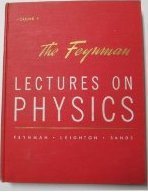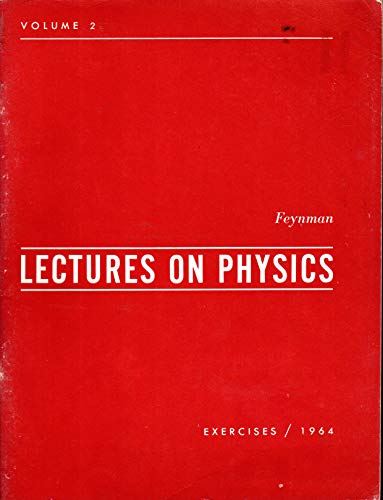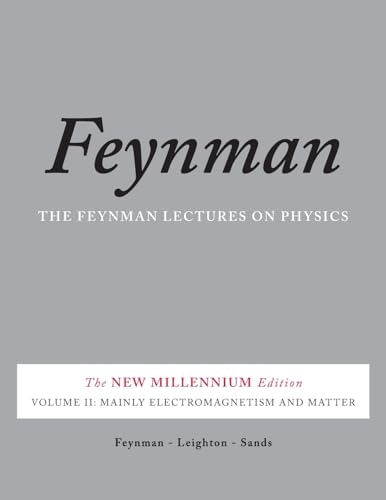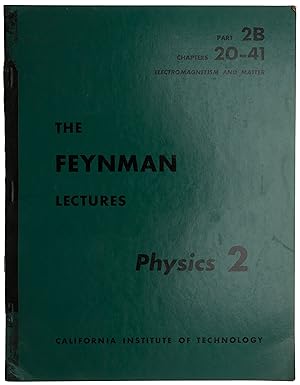lectures physics electromagnetism matter von feynman richard (10 Ergebnisse)
Suchfilter
Produktart
- Alle Product Types
- Bücher (10)
- Magazine & Zeitschriften (Keine weiteren Ergebnisse entsprechen dieser Verfeinerung)
- Comics (Keine weiteren Ergebnisse entsprechen dieser Verfeinerung)
- Noten (Keine weiteren Ergebnisse entsprechen dieser Verfeinerung)
- Kunst, Grafik & Poster (Keine weiteren Ergebnisse entsprechen dieser Verfeinerung)
- Fotografien (Keine weiteren Ergebnisse entsprechen dieser Verfeinerung)
- Karten (Keine weiteren Ergebnisse entsprechen dieser Verfeinerung)
- Manuskripte & Papierantiquitäten (Keine weiteren Ergebnisse entsprechen dieser Verfeinerung)
Zustand Mehr dazu
- Neu (4)
- Wie Neu, Sehr Gut oder Gut Bis Sehr Gut (Keine weiteren Ergebnisse entsprechen dieser Verfeinerung)
- Gut oder Befriedigend (3)
- Ausreichend oder Schlecht (2)
- Wie beschrieben (1)
Einband
Weitere Eigenschaften
- Erstausgabe (1)
- Signiert (Keine weiteren Ergebnisse entsprechen dieser Verfeinerung)
- Schutzumschlag (Keine weiteren Ergebnisse entsprechen dieser Verfeinerung)
- Angebotsfoto (3)
Sprache (2)
Preis
- Beliebiger Preis
- Weniger als EUR 20 (Keine weiteren Ergebnisse entsprechen dieser Verfeinerung)
- EUR 20 bis EUR 45
- Mehr als EUR 45
Gratisversand
Land des Verkäufers
Verkäuferbewertung
-
Zustand: New. Brand New. Soft Cover International Edition. Different ISBN and Cover Image. Priced lower than the standard editions which is usually intended to make them more affordable for students abroad. The core content of the book is generally the same as the standard edition. The country selling restrictions may be printed on the book but is no problem for the self-use. This Item maybe shipped from US or any other country as we have multiple locations worldwide.
-
Feynman Lectures on Physics, Volume 2: Mainly Electromagnetism and Matter
Anbieter: Books From California, Simi Valley, CA, USA
Hardcover. Zustand: Good. General shelfwear to the cover and page edges.
-
Zustand: Fair. Acceptable condition. No Dust Jacket Volume 2. (Physics, Science) A readable, intact copy that may have noticeable tears and wear to the spine. All pages of text are present, but they may include extensive notes and highlighting or be heavily stained. Includes reading copy only books. NOT AVAILABLE FOR SHIPMENT OUTSIDE OF THE UNITED STATES.
-
Lectures on Physics: Mainly Electromagnetism and Matter
Anbieter: Anybook.com, Lincoln, Vereinigtes Königreich
EUR 23,03
EUR 14,73 für den Versand von Vereinigtes Königreich nach USAAnzahl: 1 verfügbar
In den WarenkorbZustand: Fair. This is an ex-library book and may have the usual library/used-book markings inside.This book has soft covers. In fair condition, suitable as a study copy. Please note the Image in this listing is a stock photo and may not match the covers of the actual item,1250grams, ISBN:020102117X.
-
Zustand: Good. Good condition. No Dust Jacket Volume 2. (physics, science, lectures) A copy that has been read but remains intact. May contain markings such as bookplates, stamps, limited notes and highlighting, or a few light stains. NOT AVAILABLE FOR SHIPMENT OUTSIDE OF THE UNITED STATES.
-
The Feynman Lectures on Physics: The New Millennium Edition: Mainly Electromagnetism and Matter: Vol 2
Buch 2 von 3: The Feynman Lectures on PhysicsAnbieter: Revaluation Books, Exeter, Vereinigtes Königreich
EUR 56,03
EUR 17,07 für den Versand von Vereinigtes Königreich nach USAAnzahl: 1 verfügbar
In den WarenkorbTrade Paperback. Zustand: Brand New. 592 pages. 11.00x8.25x1.25 inches. In Stock.
-
The Feynman Lectures on Physics: The New Millennium Edition: Mainly Electromagnetism and Matter: Vol 2
Buch 2 von 3: The Feynman Lectures on PhysicsAnbieter: Revaluation Books, Exeter, Vereinigtes Königreich
EUR 86,45
EUR 17,07 für den Versand von Vereinigtes Königreich nach USAAnzahl: 2 verfügbar
In den WarenkorbTrade Paperback. Zustand: Brand New. 592 pages. 11.00x8.25x1.25 inches. In Stock.
-
Feynman Lectures on Physics 2: Mainly Electromagnetism and Matter
Buch 2 von 3: The Feynman Lectures on PhysicsVerlag: Perseus Books|Basic Books, 2015
ISBN 10: 0465024947 ISBN 13: 9780465024940
Sprache: Englisch
Anbieter: moluna, Greven, Deutschland
Zustand: New. As a fundamental aspect of our knowledge of the physical world, quantum mechanics remains a vital subject in physics. This is a collection of the late Richard P Feynman s lectures. It is suitable for students of physics and those seeking an introduction to .
-
The Feynman Lectures On Physics - Volume I: Mainly Mechanics Radiation And Heat + Volume II: Mainly Electromagnetism And Matter + Volume III: Quantum Mechanics - 7th printing
Verlag: Addison-wesley publishing company, 1972
Anbieter: crealivres, La fontennelle, Frankreich
Zustand: Good. Envoi rapide Bon état couvertures un peu défraîchies intérieurs propres. in4. 1972. Broché. 3 volume(s). The Feynman Lectures On Physics - Volume I: Mainly Mechanics Radiation And Heat + Volume II: Mainly Electromagnetism And Matter + Volume III: Quantum Mechanics. Good.
-
The Feynman Lectures: Physics 2: Part 2B, Chapters 20-41: Electromagnetism and Matter
Verlag: The California Institute of Technology, Pasadena, CA, 1963
Anbieter: SOPHIA RARE BOOKS, Koebenhavn V, Dänemark
Erstausgabe
First edition. FEYNMAN'S LECTURES ON PHYSICS- EXTREMELY RARE PRE-PUBLICATION ISSUE. Extremely rare pre-publication issue of a section of Feynman's legendary lectures on physics, namely that devoted to electromagnetism, from Maxwell's equations to the optical and magnetic properties of materials, and concluding with four lectures on elasticity and fluid flow. According to the curators of Caltech's Feynman Lectures website (), this preliminary edition was produced by Caltech's graphics department between the end of the 1962-1963 academic year and the beginning of the 1963-64 academic year. It is copyrighted 1963, one year before the first published edition of the Feynman lectures, produced by Addison-Wesley. No more than 300 copies of this pre-publication edition were printed. This section of the Feynman Lectures is a record of part of the second year's lectures, which were given to the sophomore class during the 19621963 academic year (all Caltech sophomores were required to take the class, regardless of their majors). The printed lectures were not a verbatim transcript of what Feynman said, but were edited by Leighton and Sands. "We hoped to make the written version as clear an exposition as possible of the ideas on which the original lectures were based. For some of the lectures this could be done by making only minor adjustments of the wording in the original transcript. For others of the lectures a major reworking and rearrangement of the material was required. Sometimes we felt we should add some new material to improve the clarity or balance of the presentation. Throughout the process we benefitted from the continual help and advice of Professor Feynman" (Sands). "Feynman's lectures are as powerful today as when first published, thanks to Feynman's unique physics insights and pedagogy. They have been studied worldwide by novices and mature physicists alike; they have been translated into at least a dozen languages with more than 1.5 millions copies printed in the English language alone. Perhaps no other set of physics books has had such wide impact, for so long" (Kip Thorne). "Mark Kac, the eminent Polish-American mathematician, wrote: 'In science, as well as in other fields of human endeavor, there are two kinds of geniuses: the 'ordinary' and the 'magicians'. An ordinary genius is a fellow that you and I would be just as good as, if we were only many times better. There is no mystery as to how his mind works. Once we understand what he has done, we feel certain that we, too, could have done it. It is different with magicians the working of their minds is for all intents and purposes incomprehensible Richard Feynman [was] a magician of the highest caliber'" (Biographical Memoirs of Fellows of the Royal Society of London 48 (2002), p. 99). Widely regarded as the most brilliant, influential, and iconoclastic figure in theoretical physics in the post-World War II era, Feynman shared the Nobel Prize in Physics 1965 with Sin-Itiro Tomonaga and Julian Schwinger "for their fundamental work in quantum electrodynamics, with deep-ploughing consequences for the physics of elementary particles." We are not aware of any other copy of this preliminary version of Feynman's lectures having appeared on the market, and we have located no institutional holdings other than Caltech. Matthew Sands joined the physics department at Caltech in 1950, at the same time as did Richard Feynman. They had known each other at Los Alamos and at Cornell, but at Caltech their acquaintance matured. In the 1950s, Sands served on the Commission on College Physics, which had been established to work on the improvement of physics teaching. "Until that time he had been teaching graduate courses and, with Feynman's help, had restructured the graduate curriculum at Caltech. Stimulated by his work on the Commission on College Physics, he took a close look at the undergraduate physics curriculum at Caltech and didn't like what he saw in the first two years, when students took chemistry, physics, and engineering, no mention was made of atomic physics, quantum theory, and relativity [Sands] felt very strongly that they should revise the undergraduate introductory courses in physics. At first, he got only a negative response from Robert Bacher, who was then head of the division of physics, mathematics, and astronomy [but Sands] ultimately convinced Bacher that it would be good to modernize the program [Bacher] thought that Matt Sands himself was too radical, so he asked Robert Leighton, a quiet conservative, and Victor Neher an old collaborator of Millikan's and an excellent designer of pedagogical experiments all three to work on revising the introductory physics curriculum 'About half way through the year [1960] I [Sands] became very frustrated because Leighton kept coming back with a very traditional outline, and we could not seem to converge on a solution which would meet my requirements and his. One day I had the brilliant inspiration of saying, "Look, why don't we get Feynman to give the lectures and let him make the final decision on the contents?"' "So Sand went to see Feynman at his house and said, 'Look, Richard, you have spent forty years trying to understand physics. Now here is your chance to distil it down to the essence at the level of a freshman.' Feynman thought about it and said, 'Hmm! That might be interesting! But, you know, I have never taught freshman physics before.' Sands had seen Feynman lecture in graduate courses and seminars and was convinced that his style and thought would be very good for what he had in mind. From their discussion, Feynman obtained a good feeling for what might be possible, 'So he said he would think about it for a day or two and I saw him later on and he asked: "Do you know if there has ever been a great physicist who lectured on freshman physics?" I said, "I don't know, but I don't think so!" And he said, "I'll do it!"" (Mehra, pp. 483-484). Bacher initially opposed the idea, pa.









